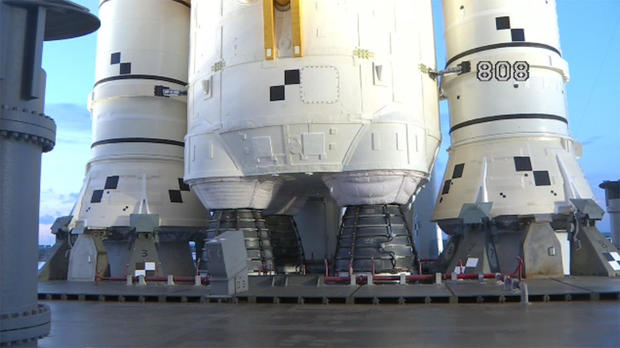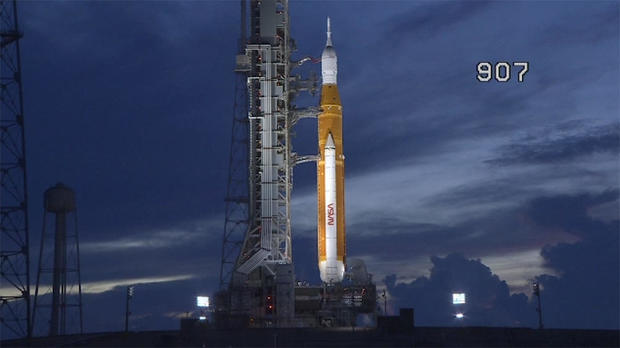NASA calls off its Artemis 1 moon rocket launch due to hydrogen leak
get the free appNASA scrubbed its second attempt to launch its Artemis 1 test flight on a long-awaited mission to send an unpiloted Orion crew capsule on a 37-day trip around the moon and back.
With a forecast calling for a 60% chance of favorable weather, engineers began fueling the Space Launch System rocket at around 6 a.m. EDT Saturday, setting the stage for blastoff at 2:17 p.m., the opening of a two-hour window.
The Saturday launch, however, was canceled due to a hydrogen leak. The decision was announced at 11:18 a.m. EDT, about 25 minutes after the team recommended "no go" for launch.
Launch was initially scheduled for Monday morning, but NASA ran into problems during fueling, forcing the agency to scrub just as the launch window was opening.
The SLS rocket — the most powerful booster NASA and its contractors have ever built — has 489 launch commit criteria that have to be met to permit a liftoff.
"We've got a whole host of things that could cause us to not get off on any given day," mission manager Mike Sarafin told reporters at a Thursday evening news conference. "There's no guarantee we're going to get off (Saturday). But we're going to show up, and we're going to try, and we're going to give it our best."
NASA administrator: "We'll go when we're ready"
NASA Administrator Bill Nelson, responding to the latest Artemis 1 launch delay, said "we'll go when we're ready. We won't go until then, especially now, on a test flight."
"This is part of our space program, be ready for the scrubs," he added.
Asked what the agency's next steps might be, he said NASA's Mission Management Team will meet later today to review the launch attempt "and see is there still a possibility" to fly before the current lunar launch window closes Tuesday. If not, the booster will be hauled back to the Vehicle Assembly Building for already scheduled servicing and post-scrub repairs. Roll back, Nelson said, likely would delay launch to mid October.
A news conference to discuss the path forward is planned later today.
Moon rocket grounded by hydrogen leak
Launch Director Charlie Blackwell-Thompson called off today's countdown after multiple unsuccessful attempts to stop a hydrogen leak in an 8-inch quick-disconnect fitting at the base of the SLS core stage. The decision was announced at 11:18 a.m. EDT, about 25 minutes after the team recommended "no go" for launch.
It's not yet known whether any repair attempts will be attempted or whether any additional launch attempts can be made before the current lunar launch period expires Sept. 6.
NASA managers said earlier a launch attempt Sunday was possible, but only if propellants were not loaded aboard the rocket. Monday is an available target date as is Tuesday, although the latter option would have a shorter window.
Either way, if the SLS isn't off the pad by Tuesday, the rocket will have to be hauled back to the Vehicle Assembly Building to service batteries in its self-destruct system, a requirement that has nothing to do with the hydrogen leak.
The available launch periods are based on the constantly changing positions of the Earth and moon, the desired lunar orbit for the Orion spacecraft and the power of the SLS rocket to put it on the resulting trajectory. The next launch period opens Sept. 19 and runs through Oct. 4. The period after that opens Oct. 17 and runs through Halloween.
Third attempt to stop hydrogen leak fails
Engineers made a third unsuccessful attempt to re-seat a leaking seal in a liquid hydrogen quick-disconnect fitting where the cryogenic propellant is fed into the Space Launch System rocket. The team is evaluating options, but time is running out to get this problem fixed in time to launch during today's two-hour window.
The latest attempt to seat the seal used the same approach that was initially employed without success: stopping the flow of hydrogen, letting the hardware warm up and then restarting the flow in hopes the thermal shock would force the seal to properly seat. As with the first such attempt, as soon as hydrogen began flowing back into the rocket, sensors detected a buildup of gaseous hydrogen, indicating the leak was still present.
It's not clear what other options might be available, but NASA cannot press ahead with fuel loading until the leak is stopped.
Second attempt to stop a hydrogen leak fails
A second attempt to properly seat a seal in an 8-inch hydrogen quick-disconnect fitting has failed. After using helium to increase pressure in the line in an attempt to push the seal into place, hydrogen resumed flowing into the SLS rocket's core stage tank. But again, sensors detected unacceptable leakage.
Engineers are now discussing what else might be done to get fueling back on track. Whether NASA can get the rocket ready to launch before the end of today's two-hour window is not yet known.
Suspect seal still leaking at higher flow rates
As it turns out, the suspect seal in a liquid hydrogen quick-disconnect fitting is not properly "seated" after all. Engineers say it still leaks at higher flow rates, so they've developed a plan to increase pressure in the line using helium in a bid to force the seal into place. The core stage hydrogen tank is only 8 percent full at this point, while the oxygen tank is nearly 70 percent filled.
Meanwhile, the delay getting the SLS rocket's core stage tanks topped off has delayed loading of the upper stage tanks. NASA has not yet said how the delays might affect today's launch window.
Fueling resumes after engineers resolve hydrogen leak
After detecting a leak at a seal in an 8-inch quick-disconnect fitting where liquid hydrogen propellant enters the base of the Space Launch System rocket, engineers stopped fuel loading and worked through a procedure to warm up the components to allow temperature to equalize. That helped the seal to "seat" properly and engineers were able to restart hydrogen loading.
But the starts and stops in the fueling process have delayed the so-called "kickstart bleed," a procedure to flow liquid hydrogen through the RS-25 engine plumbing to condition them to the low-temperature propellant before they're fired up for launch. Uncertainty about engine cooling Monday was a major contributor to a launch scrub.
Meanwhile, propellants are flowing into the core stage oxygen and hydrogen tanks and engineers are making preparations to begin loading the rocket's upper stage.
Hydrogen leak interrupts fueling
Hydrogen loading has stopped again, this time due to a leak in an umbilical quick-disconnect fitting at the base of the SLS core stage, one that was leak free during previous fuelings.
A brief leak in a different umbilical line contributed to Monday's launch scrub, but that one was resolved by waiting for temperatures to equalize across the fitting. Engineers are trying the same fix now.
In the meantime, with hydrogen flow stopped, liquid oxygen fueling has been slowed down to ensure balanced temperatures and tank shrinkage as the supercold propellants fill the core stage.
Countdown resumes; fueling continues
The countdown resumed at 7:07 a.m. EDT after a two-hour 30-minute hold. Propellant loading began on time and after resolving two minor problems, engineers contionued loading liquid hydrogen and oxygen into the SLS rocket's core stage.
After the core and upper stages are topped off and in "stable replenish" mode, the countdown will pause again for a planned 30-minute hold at the T-minus 10-minute point. If there are no technical issues and the weather cooperates, the count will resume at 2:07 p.m. for a launch attempt at 2:17 p.m. If problems do, in fact, crop up, the countdown can hold indefinitely at the T-minus 10-minute point.
NASA begins fueling Artemis moon rocket
With clearance from NASA's Mission Management Team and Launch Director Charlie Blackwell-Thompson, engineers working by remote control began fueling operations at 6 a.m. EDT, sending liquid oxygen and hydrogen from storage tanks to the Space Launch System rocket to kick off a six-hour procedure.
An updated forecast calls for showers to move on shore later in the morning, but the afternoon sea breeze should push them to the west. At the opening of today's two-hour launch window — 2:17 p.m. — forecasters are calling for a 60% chance of favorable weather, improving to 80% "go" in the final hour.
Countdown enters planned hold before start of fueling
The Space Launch System rocket's countdown to launch on the unpiloted Artemis 1 moon mission entered a planned built-in 2-hour 30-minute hold at the L-minus 9-hour 40-minute mark at 4:37 a.m. EDT (0837 UTC).
Mission managers reviewed flight preparations and, around 5:30 a.m., cleared the team to proceed with fuel loading. Liquid oxygen and hydrogen fuel will begin flowing through transfer lines to the SLS rocket around 6 a.m., kicking off a six-hour loading procedure. The countdown is expected to resume at 7:07 a.m. Launch remains on track for 2:17 p.m., weather permitting.
How to watch the Artemis 1 launch
- What: NASA launches the Artemis 1 mission, sending an uncrewed spacecraft to orbit the moon
- Date: Saturday, Sept. 3, 2022
- Time: Two-hour launch window opens at 2:17 p.m. EDT
- Location: Kennedy Space Center, Florida
- Online stream: Live on CBS News in the video player above and on your mobile or streaming device
- Follow: Updates on Twitter @cbs_spacenews
What to expect at launch time and beyond
The launch, when it happens, will be an impressive sight. The SLS has four shuttle-era engines and two extended strap-on solid fuel boosters that will generate a ground-shaking 8.8 million pounds of thrust to propel the 5.7-million pound rocket away from pad 39B at the Kennedy Space Center.
The rocket's portion of the Artemis 1 mission will last just an hour and 36 minutes, boosting the Orion capsule and its European Space Agency-supplied Orion service module into space, out of Earth orbit and onto a trajectory toward the moon.
After a close flyby at an altitude of just 60 miles, Orion will whip back out into a distant orbit around the moon for two weeks of tests and checkout.
If all goes well, the capsule will fall back toward the moon for another close flyby that will set up a high-speed descent back to Earth, with a Pacific Ocean splashdown on October 11.
Paving the way to send astronauts back to the moon
NASA plans to follow the Artemis 1 mission by launching four astronauts on a looping around-the-moon flight in 2024. That would be followed by the first astronaut landing in nearly 50 years, near the south pole. The first woman and the next man could step onto the lunar surface in the 2025-26 timeframe.
It's believed there may be ice deposits in lunar craters near the pole, and future astronauts may be able to "mine" that ice if it's present and accessible, converting it into air, water and even rocket fuel to vastly reduce the cost of deep space exploration.
More generally, Artemis astronauts will carry out extended exploration and research to learn more about the moon's origin and evolution and test the hardware and procedures that will be necessary before sending astronauts to Mars.
But first, NASA must prove the rocket and capsule will work as planned — and that begins with the Artemis 1 launch.
The goal of the Artemis 1 mission is to put the Orion spacecraft through its paces, testing its solar power, propulsion, navigation and life support systems before the 25,000-mph plunge back into Earth's atmosphere that will subject its protective heat shield to a hellish 5,000 degrees.
Testing the heat shield and confirming it can protect astronauts returning from deep space is the No. 1 priority of the Artemis 1 mission.



